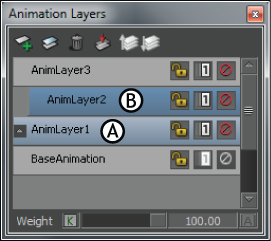Parenting is a way of linking layers in a hierarchy. Linking layers in this way is called parenting, because the source layer is considered a “parent” and the target, or subordinate, layer is called a “child”. Manipulating a parent layer can affect its child layers.
You can parent and unparent animation layers to organize and group your animation layers. See Parenting and unparenting animation layers, Organizing animation layers, and Comparing animation on different layers.

Animation Layer editor A. Parent layer B. Child of AnimLayer1
When a layer is parented to another layer, the relationship is called a hierarchy. In a hierarchy, multiple layers can be parented to a single layer, which in turn can also be parented.
If you organize your layers into hierarchies, it is important to note that the state of the parent layer can affect the child layer when you mute, weight, and select layers.
Muting a parent layer mutes its child layers. Child layers cannot be unmuted when their parent is muted, although they can be muted independently of their parent. See Muted layer.
A layer’s weight determines to what degree its animation plays in the result animation. See Animation layer weight.
The child layer’s weight is affected by its parent’s weight. The child’s weight in the result animation is calculated by multiplying its own Weight value by its parent’s Weight value, then dividing by 100.
For example, take a child layer’s Weight set to 90 and its parent layer’s Weight set to 50. Multiply 90 by 50, then divide by 100. When you play the result animation, the weight of the child layer is 45.
A child layer is deselected if its parent layer is collapsed and deselected. If a collapsed parent is selected, its child layer is not necessarily selected.
As long as a child layer is the current layer, it can still receive keyframes even if its parent layer is collapsed and deselected.
See Selecting layers.
 Except where otherwise noted, this work is licensed under a Creative Commons Attribution-NonCommercial-ShareAlike 3.0 Unported License
Except where otherwise noted, this work is licensed under a Creative Commons Attribution-NonCommercial-ShareAlike 3.0 Unported License